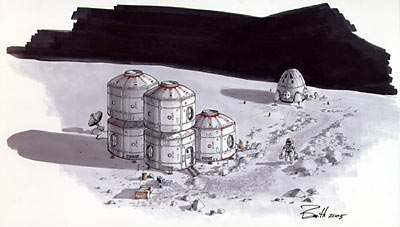The most important in situ resource is moneyby Sam Dinkin
|
| By exploring revenue producing technologies, NASA can offset expenditures and “enable new mission concepts”. |
With the exception of subtopic X14.01 (Space-Based Industries), the 114 NASA Small Business Innovation Research (SBIR) topics for the agency’s most recent solicitation that just closed this week are all about researching enabling technologies that will make new tasks feasible and make missions more capable and cheaper. More capable and cheaper is good if NASA wants to buy the most science, exploration, aeronautics and space operations with its dollars. But reducing expenditure is only one half of the cost minimization equation. Getting more dollars also buys more science, exploration, aeronautics and space operations.
Water projects generate revenue from selling the water and selling the power. Parks defray costs with entry fees and concession fees. Roads garner tolls and extra gas taxes. Mineral rights get bought outright. Range lands get grazing fees. All of these programs are subsidized. Nevertheless, the point is that they are subsidized less than if these programs did everything they did now, except took in no revenue.
Here we are with suborbital space tourism estimated revenue in the literature anywhere from $700 million/year in 2020 to billions. Perhaps NASA should be studying how to defray costs of the space station with visits like the Russians do.
NASA may actually have to deal with a flood of interest and huge new capabilities to make revenue. Elon Musk just announced Falcon 9: $27 million for 9,500 kilograms, or less than $3,000/kg including range costs and third party insurance. It’s a little early to announce the dawn of a new era of cheap space access seeing how even Falcon 1 has not even flown yet, but if it flies, and so later does Falcon 13 or 19 or whatever, then $1,000/kg is within reach by 2010 as Elon predicted at the International Space Development Conference in May.
The 9,500 kg would be able to carry about 40 space tourists up. If they split the $27 million between them, they might be able to pay ticket prices of $675,000 to orbit. That may sound like a lot, but Futron’s Space Tourism Market Study assumes the price will be ten times that in 2018. Even if it is double that to pay for food and consumables for a space hotel (not to mention the trip home), we would still be at one-tenth the 2008 price that Futron predicts. Instead of four tourists a year, we might have thousands. According to their orbital demand curve, a 50% decrease in price results in a 400% to 1100% increase in demand. If we hit $1.3 million, that is about one-sixteenth of today’s prices. We might see demand of 4,000 passengers a year if we use 750% as the increase in demand for a 50% decrease in price and start with Futron’s estimated demand of 60 passengers in 2021 at $5 million each and cut prices by three-fourths. That’s $5 billion per year in demand, or about double what we pay for satellite launches now. Recall Futron did not include demand from games and promotions so that level of demand may be underestimated by half.
NASA should start thinking like the National Park Service and the Department of Transportation. The public could actually use its facilities and pay for the privilege.
There are of course dozens of other possibilities for raising revenue in space:
- Space power satellites should get a renaissance if people worry too much about oil prices and low-cost space access materializes.
- Interment
- Entertainment
- Teleoperated space telescopes
- Souvenirs (Moon rocks, glass bulbs with “natural” vacuum inside)
- Historical artifacts
- Garbage collection
- Art
- Sales of hydroponics fresh food and other luxury consumables
- EVA rides
- Space equipment rentals
- Phone and video calls
- Videographers
- Weddings
| NASA should start thinking like the National Park Service and the Department of Transportation. The public could actually use its facilities and pay for the privilege. |
Many of these ideas are money losers. NASA should figure out which ones are money makers and either partner with private industry and get a concession fee or just do the business. (An auction would be a good way to discover prices for concessions for each of these.) By researching revenue generation opportunities and markets, NASA can enable private industry to open near space for NASA so NASA can move on to far space. NASA will be able to achieve cheaper space access through economies of scale. It will also have more revenue, so it costs the taxpayers the least for the most service. So NASA should start looking at SBIR topics on the revenue side, and not just the expenditure side. If the in situ resource is credit card numbers and accounts receivable, that weighs a lot less than propellant and food.
